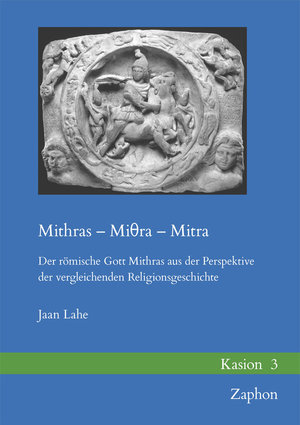
Mithras – Miθra – Mitra
Der römische Gott Mithras aus der Perspektive der vergleichenden Religionsgeschichte
von Jaan LaheDer römische Mithras-Kult gehört zu den sog. „orientalischen Kulten“, die sich im Imperium Romanum verbreiteten. Obwohl die antike Überlieferung ihn als einen persischen Kult betrachtet und auch viele Forscher seit dem „Vater der modernen Mithras-Forschung“, Franz Cumont, von seinem iranischen Ursprung überzeugt gewesen sind, sprechen alle Angaben, die uns zur Verfügung stehen, gegen dieser Ansicht und bestätigen, dass der römische Mithras-Kult kein Importkult aus dem Iran war, sondern ein Kult, der innerhalb der Grenzen des römischen Imperiums entstand und sich hier seit dem Ende des 1. Jahrhunderts verbreitete. Der Autor des vorliegenden Buches geht von der Anschauung aus, dass der römische Mithras-Kult nicht mit dem Kult von Mithra im hellenistischen Osten oder sogar in der iranischen Religion identisch ist, sondern man ihn als einen eigenständigen Kult im Rahmen der römischen Religion betrachten muss. Gleichzeitig ist aber der Autor davon überzeugt, dass zwischen den drei genannten Kulten ein wichtiges Bindeglied existierte. Es ist nicht nur der Name des Gottes, der auf ein indoiranisches Appellativum mitra (Neutr.) zurückgeht, sondern die Gestalt oder Persönlichkeit des Gottes, der im römischen Reich den Namen Mithras, im hellenistischen Orient Mithra oder Mithres und im Iran Mithra/Miθra (später Mihr) trägt. Der Autor vergleicht auf der Basis der literarischen, epigraphischen und numismatischen Quellen und Darstellungen des Gottes die Persönlichkeit des „Mithras“ und zeigt, dass auch die Gestalt oder Persönlichkeit des Gottes nicht gleich ist und in jeder Religion oder im jedem kulturellen Raum einen „individuellen Charakter“ hat, der ihn von seinen Namensgenossen unterscheidet. Die Studie ist bereichert durch zahlreiche Illustrationen und einen umfangreichen Index.The Roman Mithras cult is one of the so-called “oriental cults” that spread throughout the Roman Empire. Although ancient tradition regards it as a Persian cult, Franz Cumont (the “father of modern Mithraic-study”), and many scholars have been convinced of its Iranian origin. All the information presently available to us opposes this view and suggests that the Roman Mithras cult was not an imported cult from Iran, but a cult that developed within the borders of the Roman Empire and grew there after the end of the first century A.D. The author of the present book assumes that the Roman cult of Mithras is not identical with the cult of Mithra/Mithras/Mithres in the Hellenistic East or even in Iranian religion, but must be regarded as an independent cult in the context of Roman religion. At the same time, the author is convinced that an important link existed between the three cults mentioned above. It is not only the name of the god, which goes back to an Indo-Iranian appellative mitra (Neutr.), but also the figure or personality of the god, who in the Roman Empire was called Mithras, in the Hellenistic Orient Mithra or Mithres and in Iran Miθra/Mithra (later Mihr). The author, on the basis of the literary, epigraphic and numismatic sources and other representations of the god, compares the personality of “Mithra” (used here as the summary meta-name for different deities). The author shows that the figure or personality of the god in the aforementioned regions is not identical and has in each religion or in each cultural space its “individual character”, which distinguishes him from his namesake. The study is supplemented by illustrations and an extensive index.






